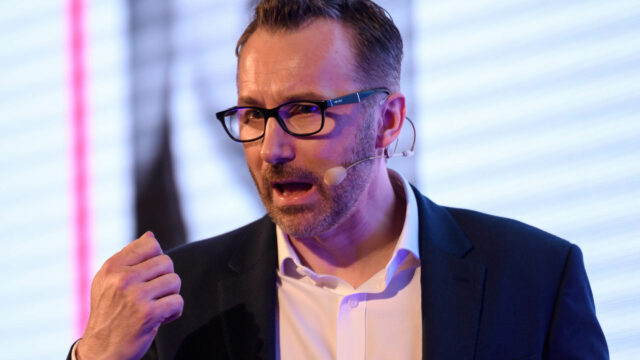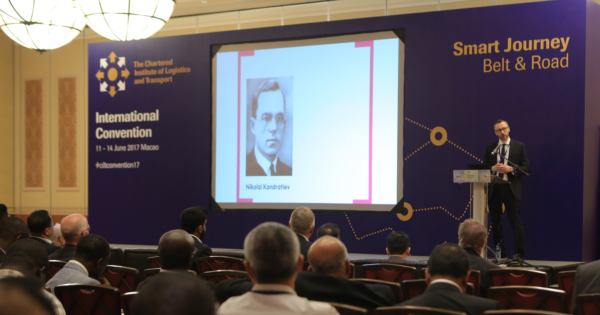Culey, Creative Destruction and the Dawn of K-Wave 6

The world is changing. New tools, technologies and ideologies are redrawing the boundaries of what is humanly possible. In an informative and far-reaching presentation at CILT International Convention in Macao, renowned business transformation expert Sean Culey put these changes into a historical context, and explained how the cyclical nature of capitalism and the exponentially powerful effects of technology mean we are on the verge of a new paradigm in human progress.
Bending the Curve of Human History
“This is the most important chart you’re ever likely to see.” Sean points to an index of World Population and Social Development over time. What is remarkable is the minimal change exhibited either in development or population between 2000 BC and 1700 AD. Then in the 1700s both measures begin to spike, and carrying on rising steeply up to today’s date. “What happened? What happened was we learned. We learned how to take natural forces, and combine them with engineering in order to create engines, engines that allowed us to take water from mines, that allowed us to dig coal from the ground to power more engines that drove industry, and that bent the curve of human history.”

Known now as the First Industrial Revolution, it is arguably the most important event in human history since the domestication of animals. It also marked the beginning of a cyclical system of innovation and exploitation first proposed internationally by Soviet Economist Nikolai Kondratiev in his 1925 book The Major Economic Cycles. Tasked by Stalin with providing the theoretical backing to the assertion that the Great Depression signalled the end of capitalism and the beginning of the new era of communism, Kondratiev instead suggested that capitalism was cyclical in nature, and western economies would soon renew themselves, becoming stronger and more advanced. It was an unpopular idea in Soviet Russia, resulting in Kondratiev being internally exiled and his work buried. He was however right, and his name is used to described each discrete cycle or Kondratiev Wave.

Creative Destruction
Following in the footsteps of Kondratiev was Austrian-born economist Joseph Schumpeter. “Schumpeter wanted to know why, and he concluded there are two actors at play here, the entrepreneur and his innovations, and he named it Creative Destruction, the forces of Creative Destruction.” Sean uses a diagram of a single K-Wave, shown as a bell curve, to demonstrate. “At the front of the curve are a lot of behaviours. Behaviours of experimentation, of innovation, of invention, and at the back here it’s more about exploitation and efficiencies.”
K-Wave 5, or the Information Age has been no different. Beginning in 1971, and characterised by the rise of digital communications and e-commerce, K-Wave 5 has been driven by something called Moore’s Law. Moore’s law refers to an observation made by Intel Co-Founder Gordon Moore in 1965 that the number of transistors per square inch on integrated circuits had doubled every year since their invention. He predicted this trend would continue into the foreseeable future. Although the pace has slowed, the number of transistors per square inch has in fact doubled approximately every 18 months since. Sean illustrates this phenomenon using the price of computer memory. “In 1980 for three and a half thousand dollars you could get 10mb of data, this year you can go onto Amazon and get a terabyte for fifty-four dollars ninety-nine cents, which is 100,000 times the memory for 1.5% of the cost.”
50 Million Users in 19 Days
Like K-Wave 3, K-Wave 5 ended in spectacular disaster, and a global economic downturn whose repercussions are still being felt around the world. But for Sean, all is far from lost. In fact, the future looks brighter than ever. “When we look back since the Industrial Revolution, we can see that each wave brought with it new power sources, new transport mechanisms, new communication mechanisms, and it created new industries.” Of equal importance is the fact that the cycle is speeding up. Globalisation and digitalisation have increased the rate at which new ideas and technologies diffuse and saturate civilisation. As an example, Sean compares the adoption of the telephone to the internet and Pokémon Go. “Where it took 75 years for the telephone to reach 50 million users, 38 years for Radio, 13 for TV, it took 4 years for the internet, three-and-a-half for Facebook and just 19 days for Pokémon Go.”
This change of pace is evident in more than just apps and social networks. “Imagine suggesting in 2007 that in 10 years’ time people worldwide would own cars that could drive themselves, park themselves, be summoned from across town using a phone, use electricity as fuel, do 0-60 in under 3 seconds, refuel themselves in your garage, drive 300 miles on a single charge, and be upgraded automatically while you sleep. And all from a start-up you’ve never heard of who won’t make a production car for another five years.” He is of course referring to Tesla, whose vehicles are rapidly changing the face of the automotive industry, and manufacturing in general.
Welcome to the In-Between
Even as K-wave 5 collapsed in on itself, some of the forces that will lead K-Wave 6 were already beginning to emerge. But they’re not all on-stream yet. “We are now at the transition point between the old wave and the new wave, and these are disruptive times.” Sean quotes Beth Comstock, Vice Chair of General Electric. “Get used to living in the in-between. The old is going away, and the new has not yet fully emerged. It’s uncomfortable and it’s chaotic. But it’s happening in pretty much every industry right now.” But for Sean too much of the world’s industry is still currently attached to the behaviours of the old wave. “A lot of businesses are still in the mind-set of sweating assets, off-shoring labour, of getting more cost out of supply chain, when in fact we’re in a new wave.”

During this transition period, many business paradigms have been inverted. Sean references an article in TechCrunch by Tom Goodwin, which points out “the world’s largest taxi company owns no vehicles, the most popular media owner creates no content, the world’s most valuable retailer holds no inventory, the world’s largest accommodation provider owns no real estate, the largest communications companies own no infrastructure, and the world’s largest movie house owns no cinemas.” Sean continues, “We’re now in a world where a six-year-old company that makes an app that lets you hail a car is more valuable than the companies that make the cars.”
A Human Supply Chain, For Now
Turning the conversation to the logistics industry, Sean notes that these changes are yet to have a major impact. “The global supply chain is still very much a human supply chain.” He shows two photos of factory workers for comparison. “If you look at these two images 100 years apart, one in the US, one in China, they both show people doing the same thing – working in rows, making stuff.” But Sean and many others believe this is about to change. “I want to talk to you about the impact of Creative Destruction on the supply chain…we are facing a future where machines replace muscle, algorithms and AI automate knowledge work, and the two converge, where machines control machines.”
The industrial application of robotics is not new, but for Sean the nature of such applications has changed dramatically. “Let’s use farming as an example. While agriculture was the first industry to be automated, there has always been the need for migrant labour to pick things out of the ground – fragile produce that a machine would damage. Until now.” He shows a video of the new breed of agricultural robots, including the Ladybird Robot. It is an automated farming robot designed by Professor Salah Sukkarieh of the University of Sydney that is able to inspect fruit trees, count individual fruit, differentiate between plants and weeds, and exterminate weeds with herbicide. As Sean sees it, the new paradigm isn’t just about adding robots to agriculture, it’s about rethinking agriculture. “Do we even need land? Over in Japan they have indoor farms. Companies are dedicating floors to growing fresh fruit and vegetables that are going down to the canteens for people to eat during the day.” The first so-called robofarm was started in 2016 with the aim of harvesting 30,000 of lettuce per day, indoors, without human labour. Such high productivity is not the only perk, as Sean points out, “because they’re doing it inside they’re using 95% less water, no herbicides or pesticides, no seasons, and no contamination…all without humans.”
He turns to the mining industry for another example, showing a photo of a Rio Tinto employee in Perth running an iron ore mine 1500km away in the outback. “He’s able to do that because all of the vehicles in the mine are autonomous.” In fact, Rio Tinto has been so successful with their autonomous mine they have since automated the trains that export the ore, and are working their way through the supply chain. This increased level of remote control and autonomy is not limited to mining. Sean cites Rolls-Royce’s intention to create an entirely autonomous shipping fleet, and the industry wide expectation that almost all shipping will be autonomous by 2035.
Meet Baxter
Alongside breakthroughs in the field of autonomous technology, the next big thing in manufacturing is the rise of the collaborative robot. “We’ve had robots in manufacturing for a while now, but usually they’re big, dumb, designed to do just one thing, and as a result they have to be put in cages because if you get in the way they can kill you. But robots are getting smart.” He demonstrates his point with a video of the NextAge robot. It shows the robots working side-by-side with humans on a factory floor, filling places on a production line originally staffed by humans. “It’s impressive”, he says, “but I want to introduce you to something a little smarter. It’s called Baxter.”

Introduced in 2012 by Rethink Robotics, the company set up by Rodney Brooks, the man who created the Roomba, Baxter was designed to be able to perform tasks on a production line. Most important is Baxter’s collaborative nature. Such collaborative robots or ‘cobots’ are equipped with multiple sensor arrays, and are carefully programmed so they can integrate into a human workforce, without causing disruption or danger. Furthermore, they are not task-specific, instead able to adapt to almost any menial task. This changes the barriers to entry for robotics as owners are able to invest in the technology without it limiting them to set processes and workflows. A change in demand means a change in robot programming rather than the re-tooling of an entire factory, and the replacing of now obsolete hardware. “The thing about Baxter is it’s a platform; its capabilities can be changed and enhanced via software updates. If you want it to perform a new task, you teach it by just guiding it. The latest software update, Intera 5, adds force sensitivity to Baxter, so it knows when it is feeling something. It’s basically a platform you can adapt to your use, allowing it to do a multitude of different tasks and work in a multitude of industries.”
You’re Paying for the Dude in the Car
From the impact on sourcing and production, Sean moves on to the impact of K-Wave 6 on logistics. “Delivery is not traditionally an area that has been a home for robotics, but this is changing. The warehouse is becoming automated.” He illustrates his point with Kiva robots, 45,000 of which operate in Amazon’s warehouses. Kiva Systems were bought by Amazon in 2012 for $775 Million, and the subsequently created Kiva robots are a linchpin in the Amazon warehousing operation. The resultant gains are substantial, with Amazon able to reduce the cost of picking an item from $0.448 per unit when done by a human to $0.213 per unit using the Kiva bots. Deutsche Bank estimates that rolling out Kiva robots across all 110 Amazon warehouses will save the company $2.5 billion a year.
Though open world applications of these technologies are on the rise, they are still in the deceptive stage, a period described by Peter Diamandis as one where “exponential growth goes mostly unnoticed…because the doubling of small numbers often produces results so minuscule they are mistaken for linear growth. To the casual observer it is just that, yet big change is on the horizon.” Once these technologies break onto the open market, they will go from deceptive to disruptive. Sean quotes the CEO of Uber, Travis Kalanick, talking about how the cost of using Uber will plummet when cars become autonomous, “You’re not just paying for the car, you’re paying for the dude in the car. When there’s no other dude in the car, the cost of taking an Uber becomes cheaper than owning a car.” Outside of taxis, autonomous capabilities have real importance for companies needing to move a workforce around, even more so for companies needing to move goods, and the removal of ‘the dude in the car’ is well under way. Otto is a self-driving technology company set up by one of Google’s autonomous vehicles engineers, and acquired by Uber in 2016. Although Uber has since retired the brand name, in that year Otto successfully completed deliveries of Budweiser across the US. As Sean explains, “the unique thing about Otto is that they are able to upgrade existing vehicles into autonomous ones, meaning that you don’t need to buy a new rig.”
Your Friendly Neighbourhood Mothership
Last mile logistics are also changing. Sean points to the increasing use of drones, not just as a novelty, but as an efficient delivery channel. Companies like Amazon, Google and Alibaba are investing heavily in drones as a new, low cost and human-free delivery method. Car company Daimler AG has invested £17 million in robotics start-up Starship to develop a ‘mothership’ concept consisting of a cargo van adapted to carry a group of road delivery robots. Upon arrival at a point determined to be the most efficient, the van parks, and the robots disembark and deliver individual orders to separate households, returning to the van automatically. Reloading with another order is also fully automated. Once all deliveries are complete, the drones return to the van and the van moves on to the next delivery location. This Mothership concept is not limited to the ground. Amazon are looking at removing completely the problems of storage space in built-up areas by taking to the skies. In 2015 they filed a patent for an airship that serves as a floating fulfillment centre, with a swarm of air-borne drones delivering order after order. UPS is also trialling a concept similar to the Starship-Daimler collaboration, but using airborne drones with the traditional UPS van as a launch pad.
Amazon’s New Weapon
Alongside this revolution in delivery, is a revolution in point-of-sale systems. Sean displays a photo of what appears to be a man choosing a soft drink from a chiller cabinet. “In 2012 Tesco took over a company called Homeplus in South Korea. What you’re looking at there is people buying stuff with a smart phone. There doesn’t appear to be anything really smart about that until you realise that it is actually the side of a train. It’s a subway station and they’re using blank space to put up virtual images of shelves filled with products, all with 2-D barcodes allowing people to buy them. So now retailers don’t need to rent expensive areas of land to sell their wares, and can put products where the consumers are, rather than expecting them to travel to the retailer. This could take the form of a pillar, or a bus stop, and it can be turned into a mini-store that people can order their impulse and essential items from and get them delivered shortly after they get home.”

Then there are devices like Amazon Echo. “Most people think it’s a speaker. It’s not, it’s a platform with a purpose, a purpose to attack every other online retailer by stopping you from even having to go online to order goods…Just say out loud what you want and it arrives.” Amazon have made this change in point-of-sale a core part of their strategy, combining it with the Dash Replenishment system, launched in 2015, which allows users to order specific items with the click of a wireless, moveable button. The arrival of the Internet of Things is moving this trend forward to a world of smart machines, aware of when they are low on materials and able re-order them automatically. “I didn’t even know the printer was out of ink until the replacement ink arrived.”
Destruction
Alongside all of this creation there is plenty of destruction, and more to come. The First Industrial Revolution benefitted from a surplus in manpower created by early agricultural reforms, but this also meant there were no longer as many farm jobs to be had. Those unable to adapt to the new way of life, working in factories, were simply unable to find employment. Although the driverless vehicle is an exciting prospect, it is worth remembering that 8.7 million people currently work in the US trucking industry alone. The problem is not just that these jobs are disappearing, but many of those left unemployed will have an obsolete skill set, and be unlikely to be able to retrain into a new, emerging industry. As Sean points out, this means the jobs market is heading toward a paradox: “We’re going to have massive unemployment and a skills shortage at the same time.” He refers to comments made by Alex Harvey, the Head of Robotics and Autonomous Systems at online retailer Ocado, who when asked if he is planning to retrain warehousemen made unemployed by the full automation of their fulfillment centre replied “Of course I’m not. I can’t retrain a guy who picks and moves stuff to be a machine learning specialist.”
New Thinking
Though somewhat punchy, Harvey’s comments are not wrong. There will be a large number of people left stranded by the pace of technological change, and what to do with them, what to do with us, is going to be a huge challenge, requiring a redefinition of work and its value to society. Bill Gates, Founder of Microsoft, suggests all robots who take human jobs should be taxed. Others have called for a national wage, a share of the robotic harvest distributed to every citizen. These things alone do not look likely to work, and Sean is realistic about how much further we will need to go. “So, what shall we do? Shall we break the machines once again like the Luddites? I’d say no. Go back through history, any civilisation that has tried to hold back innovation has failed. It might stop but the rest of the world doesn’t. Therefore, we need to develop the skills and capabilities to work with this technology. We need to learn how to adapt to technology not just adopt technology. Because making machines smart is the easy bit, making a societal model that provides for seven billion humans in a world of smart machines is not so easy.”